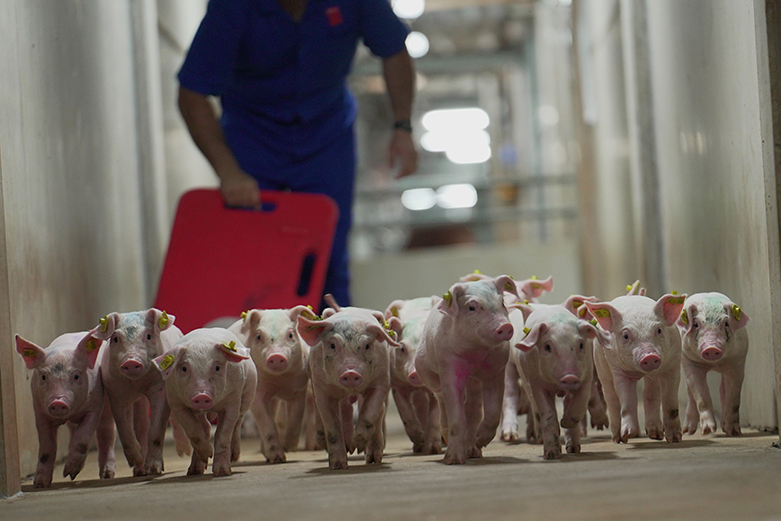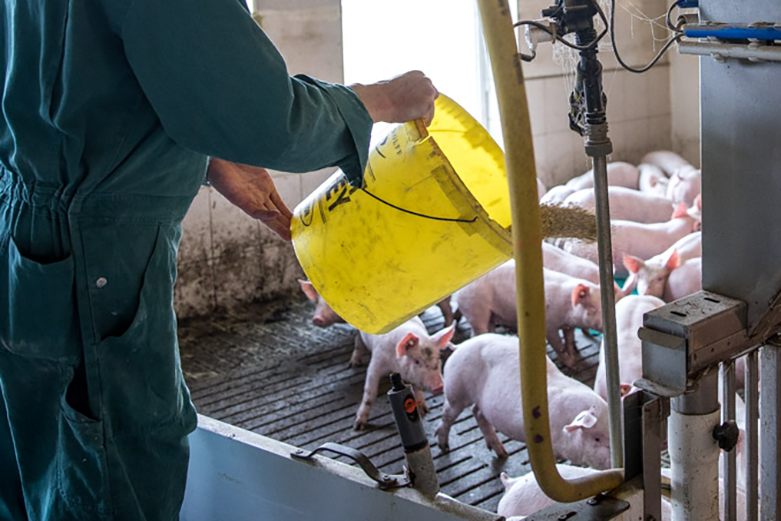WEANING OF PIGS: OPTIMAL MANAGEMENT AND NEW CHALLENGES – an 8-part series
- What happens at weaning
- Objectives at weaning for a sow
- Piglet management around weaning
- Management of piglets after weaning
- Feeding of the sow
- Piglet feeding at weaning
- Age at weaning
- Types of weaning according to piglet age
The authors:
Emilio Magallón Botaya – Veterinarian specialising in Economics and Pig Production.
Sara Beitia Delgado – Agronomist Engineer – La Almenara Farm
Pablo Magallón Verde – Technical Service PIC
David Roldan Feringan – Veterinarian-Granja La Almenara
Patricia Prieto Martínez – Veterinary Service Inga Food
Images provided by the authors
The age at weaning is different on each farm and is influenced by several factors, such as the number of farrowing places, the band management, the type of sow and the prolificacy level of the farm, the birth weight of the piglets, the sanitary conditions of the farm, the problems or not in the adaptation to the post-weaning phase, the legislation of each country, etc. The main types of weaning according to the age at which they are carried out are detailed below.
Types of weaning according to piglet age
Already in 1993 Whittemore published a graph associating the effort and benefit of age at weaning (figure 1). The benefit was reached at ages around 28 days, a figure that is becoming more and more relevant nowadays.

In the following, we will review the different ages at which weaning is carried out on farms, some of them on an experimental basis.
1. At day of birth
Once the piglets have been placed with their own mother, they can be weaned and given for adoption to another sow, even from another farm, region or country. Piglets can be transported over long distances, even by plane, as long as this do not last more than one day.
These practices were used in selection farms for disease eradication, for sale of genetic lines or even for considerable savings in transport.
2. Ultra-early: from 5-8 to 14 days
They are applied in pathogen eradication programmes and combined with all-in/all-out strategies and, increasingly, when working with hyperprolific lines with prolificacy of more than 16/18 piglets born alive, where the number of viable sow teats is lower than the number of piglets born, and we have to wean some litters totally or partially in order to have nurse sows available.
These systems require very specialised nursery facilities (figures 4 and 5), with optimal environmental conditions, and feeding the piglets with milk and lacto starters.
3. 21-day weaning
Weaning at 21 days has for a long time been the so-called “standard weaning”, promoted by the theory of “phased production” in the early days, as weaning at a maximum of 21 days was intended to eradicate certain diseases (figures 6 and 7).
This is the age at weaning that is used in 2 and 4 week batch systems.

Source: PIC

Source: PIC
Weaning by weight or age?
Getting a good piglet weight is key to reducing weaning changes, but as birth weights are falling with increasing prolificacy, weaning weights are also falling, so longer lactation is essential to achieve minimum piglet weights of 6-7 kg at weaning (figure 6). It is better to produce one kilogram of piglet with milk from the sow than with complementary feed.
It should also be considered that if many nurse sows are to be used, the weaning age of the piglets is a couple of days lower than the lactation age of the sows.
Ideal lactation length between 25 and 28 days
Having seen the different types of weanings that can be carried out in experimental conditions or in order to eradicate/control some diseases, due to the immaturity, especially intestinal, of the piglets at weaning and the care they require and the costs of weaning feed, the ideal lactation is between 25 and 28 days to achieve average weights of 7-7.5 kg, which also coincides in terms of biology with the optimal weaning of the sow (figure 7).
Therefore, each farm should establish an age at weaning that achieves, according to the prolificacy of the sows with which it works, minimum piglet weights of 6 kg and those sows are not weaned with less than 21 days of lactation to favour their uterine involution and achieve the best productivity in the following reproductive cycle.


But there is a disadvantage. With average weaning age at 21 days we go to a weaning interval of 18- 24 days, and sows younger than 18 days have a poor uterine involution which is detrimental to productivity in the next reproductive cycle (table 1).
Table 1: Summary of advantages and disadvantages of early weaning at 21 days
| Advantages | Disadvantages |
|---|---|
| Higher number of farrowings/sow/year due to shorter lactation period. | The lower the weight of the piglet, the more its viability is compromised. |
| Higher turnover of the farrowing pens due to shorter lactation duration. This results in fewer farrowing pens needed and lower costs, as these are the most expensive places on the farm. | Environmental requirements are more demanding in weaned piglets. |
| From a health point of view, healthier piglets can be weaned, as some diseases of the sow are not transmitted to the piglet at such an early stage. | As piglets are weaned at low weights, they have to spend more time in the nursery and therefore more space is needed in the nursery barn. |
| From the sow’s point of view, early weaning means less time for proper uterine involution to take place. |
4. Weaning at 28 days
This is recommended for the following reasons:
- Very good piglet weight is achieved.
- The piglet eats earlier in the post-weaning period, which reduces the latency period.
- Less digestive problems.
- Less stress at weaning.
- Better uterine involution and better productive results in the next cycle of the sow.
However, to carry out this type of weaning, more farrowing pens and more space are needed.
To be able to wean at 28 days, a minimum of 26-28% of the total number of sows in farrowing pens is recommended. It is even more important if we work with hyperprolific lines and have to make a significant number of sows nurse sows.
Partial weaning
This consists of removing a small number of piglets from the litter, the heaviest ones, so that the sow finishes the lactation less exhausted, and the small or late piglets have a better chance of having a good teat.
Sows with 14-15 piglets are left with 12-13. It is not advisable to leave sows with fewer piglets because they may come into heat in farrowing house.
This practice is advisable during the week prior to weaning.
Intermittent weaning
Intermittent weaning consists of the physical separation of the sow from all piglets in her litter in the days prior to weaning (2-12 days) for a variable period of 2 to 12 hours during which feed is administered to the piglets.
Separation periods should not be too long, as in experimental trials where sows were separated for more than 12 hours per day, up to 22 % of the sows came out of heat during lactation. It would be interesting to be able to combine pregnancies and lactations, but many of these oestrus in lactation are not ovulatory.
The objective is to favour the physiological adaptation of the piglets at weaning, when they move from a perfectly digestible food, such as milk, to a solid food that is more difficult to digest, such as feed.
It is an almost exclusively experimental management technique, impractical due to its excessive complexity and labour-intensive nature.
Conclusions
At what age is it best to wean?
- It depends on the legal conditions, facilities, management, personnel, and genetics of each farm.
- Piglet weight, transition mortality and the reproductive data of the sow: fertility and prolificacy.
- Weaning at 21 days results in lower piglet weight and productive problems of adaptation to weaning in small piglets.
At present, average weanings are around 24-26 days of piglet age and 2-3 days longer lactation in sows, due to the aforementioned effect of nurse sows raising two litters. The optimum in hyperprolific sows is weaning at around 28 days to achieve good piglet weights.
This is the 8th and final part of our series on weaning management.
This series of articles was first published in the professional journal SUIS.





